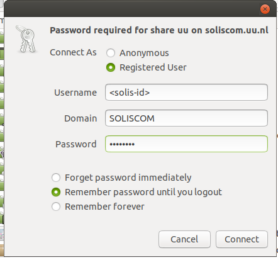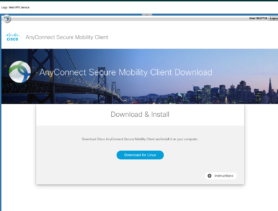How-tos
Accessing your (Research) Data
If you have suggestions on how to improve this document, or find mistakes, please send them to ilslabs@nulluu.nl
This how-to describes how to access your research data. If you want to know how to store your data, or if you need help understanding the various drives, see the how-to Storing your (Research) Data.
The project folders are stored on the O-drive, the main network drive at the UU. You can find the project folders under ‘O:/Research/GW/Projects’. Instructions for accessing the O-drive are included below.
When you log in using your Solis ID in the lab, the O drive will already be available. You will find the project folders under ‘Research/GW/Projects’.
Under Windows 10
Open drive O: (UU O-Drive). You will find your project folder under ‘Research/GW/Projects’.
Under Linux (Kubuntu v16.04)
On the Desktop use the link called UU-Drives where you will find a folder called ‘O-Drive’. Alternatively type cd /mnt/symbolic/O-Drive in a terminal.
You will find your project folder under ‘Research/GW/Projects’.
On a Solis PC (managed by ITS), the O drive will already be available.
Open drive O: (UU O-Drive). You will find your project folder under ‘Research/GW/Projects’.
Follow the directions in the ITS manual U and O drive on Windows 10 starting at step 18 to access the O-drive on your Windows 10 machine.
Once you have access to the O-drive, you can find your project folder under ‘O:/Research/GW/Projects’
- This method of connecting under VPN should work for employees as well as (RMA Linguistics) students. If you’re having problems, please let us know.
- You will need two-factor authentication to make a VPN connection; if you don’t have 2FA set up yet, you can do so at https://mysolisid.uu.nl/.
Follow the directions in the ITS manual U and O drive on Windows 10 to access the O-drive on your Windows 10 machine.
Once you have access to the O-drive, you can find your project folder under ‘O:/Research/GW/Projects’
- This method of connecting under VPN should work for employees as well as (RMA Linguistics) students. If you’re having problems, please let us know.
- You will need two-factor authentication to make a VPN connection; if you don’t have 2FA set up yet, you can do so at https://mysolisid.uu.nl/.
- Only Mac OS version 10.12 and later can definitely connect using VPN. Earlier versions of Mac OS have faulty features that cannot be circumvented. If the VPN connection is refused, restarting your computer often helps.
Once you have access to the O-drive, you can find your project folder under ‘Research/GW/Projects’
- This method is for the lab-laptops using Linux. If you’re using Windows on a lab-laptop, use the guide above.
- This method of connecting under VPN should work for employees as well as (RMA Linguistics) students. If you’re having problems, please let us know.
- You will need two-factor authentication to make a VPN connection; if you don’t have 2FA set up yet, you can do so at https://mysolisid.uu.nl/.
Unlike the computers in the lab, the O-drive will not be automatically available on our lab-laptops. To manually connect:
- First, start the VPN client, which should already be installed. It may either be called ‘Cisco Secure Client’ or ‘AnyConnect VPN Client’.
- Type in ‘vpn.uu.nl’ in the ‘Connect-to’ field. Then, press the connect field and login using your Solis account.
- Once you are connected, open the file-browser by double-clicking the ‘Home’ icon on the desktop or starting ‘Caja’ from the start menu.
- Connect to the O-drive by typing
smb://soliscom.uu.nl/uu/Datain ‘Location’ field and pressing enter. - You’ll be asked to login again. Provide the following info:
- Connect as: registered user
- Username: your solid-id
- Domain:
SOLISCOM - Password: your password
- And check ‘Remember password until you log out’.

You should now have access to the O-drive, and you can find your project folder under ‘Research/GW/Projects’
- These instructions are meant for those that have experience using command-line interfaces effectively.
- These instructions were tested on an Ubuntu v20.04 installation but are expected to work on nearly all Debian-based distributions.
- This method is (probably) not available to students.
Connect to the Virtual Private Network (VPN)
Firstly, make sure you install the required packages:
sudo apt update; sudo apt-get install cifs-utils keyutils
Secondly, install the AnyConnect VPN client by going to vpn.uu.nl and logging in with your Solis-ID.
You should get a ‘Download for Linux’ button. This will download an installer.

Install the client with this command:
sudo dpkg -i Downloads/icaclient_19.12.0.19_amd64.deb
Note: the filename might differ between versions.
You should now have the AnyConnect client. Open it, enter ‘vpn.uu.nl’ as the server, click connect and login.
To simplify the mount command, please set the environment variable SOLISCOM_USERNAME:
SOLISCOM_USERNAME=<Your Solis ID here!>
Ensure that the target directory has been created (we use /mnt/uilots for this example):
sudo mkdir --parents /mnt/uilots
Finally, mount the O-drive:
sudo mount -t cifs //soliscom.uu.nl/uu/data /mnt/uilots -o username=$SOLISCOM_USERNAME,domain=soliscom,uid=$UID,nounix,noserverino,vers=default
Disconnect the mount and VPN
When you are finished with the mounts, first unmount the ILS Labs data server:
sudo umount /mnt/uilots
Secondly, open anyconnect again and click ‘Disconnect’
Students and teaching staff can access the lab drives through https://solisworkspace.uu.nl/, a virtual environment where you can access your university drives and campus-licensed software through your browser. When you first log in, you will be asked whether you want to install Citrix Receiver – choose yes. To access the lab drives, go to APPS and search for “Windows Explorer”; the O-drive should be listed.

